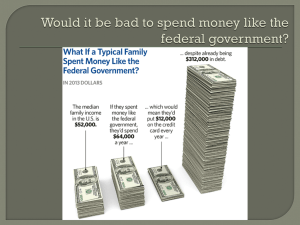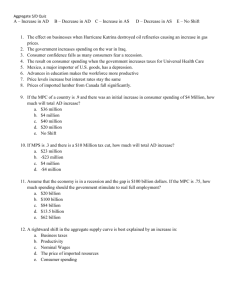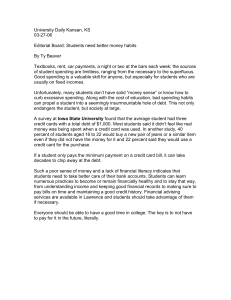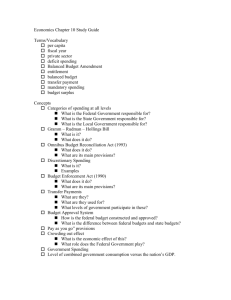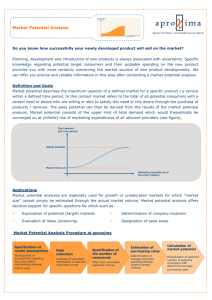World military expenditures in real terms* rose
advertisement
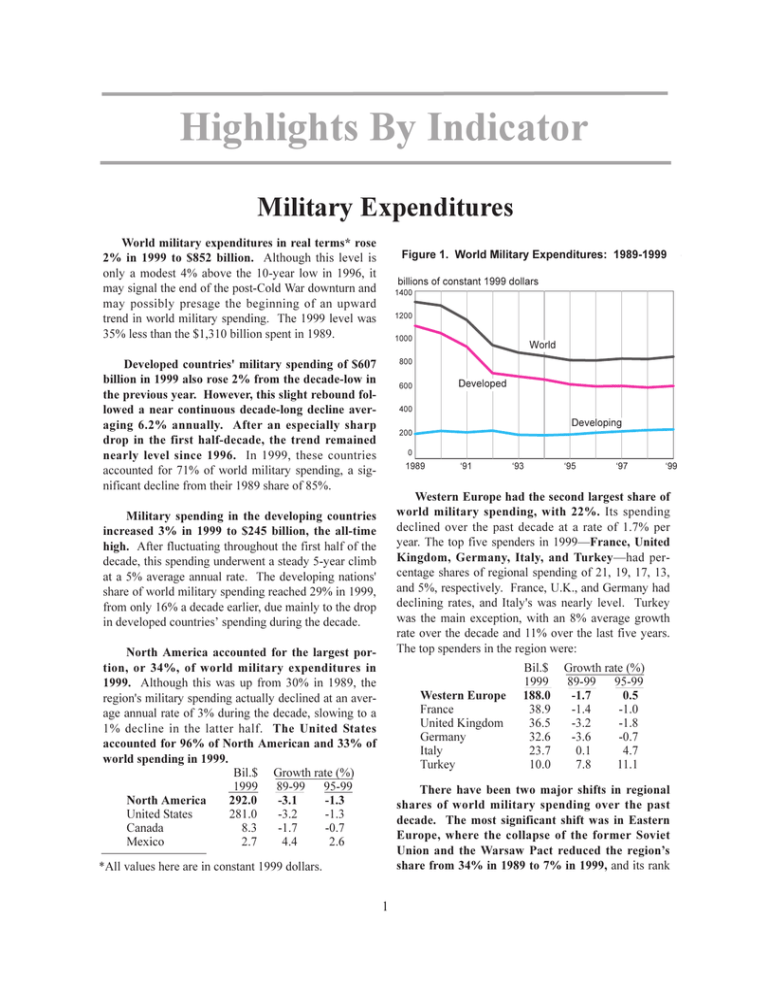
Highlights By Indicator
Military Expenditures
World military expenditures in real terms* rose
2% in 1999 to $852 billion. Although this level is
only a modest 4% above the 10-year low in 1996, it
may signal the end of the post-Cold War downturn and
may possibly presage the beginning of an upward
trend in world military spending. The 1999 level was
35% less than the $1,310 billion spent in 1989.
Figure 1. World Military Expenditures: 1989-1999
billions of constant 1999 dollars
1400
1200
1000
Developed countries' military spending of $607
billion in 1999 also rose 2% from the decade-low in
the previous year. However, this slight rebound followed a near continuous decade-long decline averaging 6.2% annually. After an especially sharp
drop in the first half-decade, the trend remained
nearly level since 1996. In 1999, these countries
accounted for 71% of world military spending, a significant decline from their 1989 share of 85%.
World
800
Developed
600
400
Developing
200
0
1989
91
93
95
97
99
Western Europe had the second largest share of
world military spending, with 22%. Its spending
declined over the past decade at a rate of 1.7% per
year. The top five spenders in 1999France, United
Kingdom, Germany, Italy, and Turkeyhad percentage shares of regional spending of 21, 19, 17, 13,
and 5%, respectively. France, U.K., and Germany had
declining rates, and Italy's was nearly level. Turkey
was the main exception, with an 8% average growth
rate over the decade and 11% over the last five years.
The top spenders in the region were:
Military spending in the developing countries
increased 3% in 1999 to $245 billion, the all-time
high. After fluctuating throughout the first half of the
decade, this spending underwent a steady 5-year climb
at a 5% average annual rate. The developing nations'
share of world military spending reached 29% in 1999,
from only 16% a decade earlier, due mainly to the drop
in developed countries spending during the decade.
North America accounted for the largest portion, or 34%, of world military expenditures in
1999. Although this was up from 30% in 1989, the
region's military spending actually declined at an average annual rate of 3% during the decade, slowing to a
1% decline in the latter half. The United States
accounted for 96% of North American and 33% of
world spending in 1999.
Bil.$ Growth rate (%)
1999
89-99
95-99
North America
292.0
-3.1
-1.3
United States
281.0
-3.2
-1.3
Canada
8.3
-1.7
-0.7
Mexico
2.7
4.4
2.6
Western Europe
France
United Kingdom
Germany
Italy
Turkey
Bil.$
1999
188.0
38.9
36.5
32.6
23.7
10.0
Growth rate (%)
89-99
95-99
-1.7
0.5
-1.4
-1.0
-3.2
-1.8
-3.6
-0.7
0.1
4.7
7.8
11.1
There have been two major shifts in regional
shares of world military spending over the past
decade. The most significant shift was in Eastern
Europe, where the collapse of the former Soviet
Union and the Warsaw Pact reduced the regions
share from 34% in 1989 to 7% in 1999, and its rank
*All values here are in constant 1999 dollars.
1
The five largest spenders in the region were:
Bil. $ Growth rate (%)
1999 89-99
95-99
Eastern Europe
62.0 -19.3
-3.4
Russia*
35.0
--5.0
Poland
6.7
-6.5
-0.7
Ukraine
5.1
--0.7
Czech Republic
3.0
-2.4
Romania
2.2
-8.5
-9.4
Table 1
Military Expenditures: Shares and Growth
(in percent)
World Share Real Growth Rate*
Decade 2nd Half
1989
1999
89-99
95-99
World
100.0 100.0
-4.6
0.8
Developed
84.2
71.2
-6.2
-0.6
Developing
15.8
28.8
0.8
5.0
Region
North America
30.0
Western Europe
16.2
East Asia
10.0
Eastern Europe
34.4
Middle East
5.4
South America
1.3
South Asia
0.8
Southern Africa
0.7
Oceania
0.5
North Africa
0.4
Central Africa
0.2
Central Asia & Cauc. —
Central Amer. & Car. 0.2
34.3
22.1
21.4
7.3
6.5
2.6
2.0
1.3
0.9
0.7
0.5
0.5
0.1
-3.1
-1.7
3.4
-19.3
-5.4
4.3
4.7
0.5
1.1
1.9
1.2
—
-6.3
-1.3
0.5
5.0
-3.4
0.8
3.9
6.8
16.2
0.0
8.4
18.2
2.9
-12.9
29.2
2.4
-9.9
0.4
-0.5
11.1
Organization / Reference Group
OECD
49.3
64.9
OPEC
4.5
5.2
NATO, all
45.0
55.8
Warsaw Pact (fmr) 34.1
7.3
NATO Europe
15.0
21.8
Latin America
1.7
3.2
CIS
—
5.3
-1.8
-6.4
-2.6
-19.4
-1.4
3.3
—
0.7
2.2
-0.2
-2.7
1.8
4.1
-3.4
Europe, all
Africa, all
50.5
1.4
The second largest shift occurred in East Asia,
whose share of world military spending more than
doubled over the decade, from 10% to 21%, with
an annual growth rate of 3.4%. This moved the
region up from fourth to third largest in spending.
The primary cause was a significant increase in
military spending by China*, which accounted for
nearly half of the region's total, had an average annual
growth rate of 5%, and rose from an estimated $54
billion in 1989 to $89 billion in 1999.
Significant spending increases by other top East
Asian militaries also contributed to the region's rising world share. Japan's real expenditures in 1999
were 20% higher than a decade earlier, Taiwan's were
80% higher, and South Korea's, 25%. High annual
growth rates in the latter half of the decade were registered by China (10%), Taiwan (7%), and Singapore
(10%), while North Korea had an estimated declining
rate of 11%. The largest military spenders in this
region were:
Bil.$ Growth rate (%)
1999
89-99
95-99
East Asia
182.0
3.4
5.0
China-Mainland*
88.9
5.1
10.1
Japan
43.2
1.8
1.3
China-Taiwan
15.2
6.1
7.1
South Korea
11.6
2.4
2.0
Burma*
4.7
6.8
1.6
Singapore
4.4
8.4
9.7
North Korea*
4.3
-4.1
-11.1
* Average annual rate, calculated as a compound rate
curve fitted to all points (see Statistical Notes for details).
from first place to fourth. The region’s average annual
rate of decline in 1989-1999 was 19.3%. After the terminal Soviet Union’s sharp drop, Russia* reduced its
real military spending by about half, from an estimated $73 billion in 1992 to $35 billion in 1999, when it
still accounted for over half of the region's total.
The Middle East had the fifth largest share of
world military spending in 1999. Regional spending
declined substantially in the first half of the decade
and was 23% lower in 1999 than in 1989. Over the
entire decade, the region declined by over 5% annually, and the top five regional spenders all had declining
rates except for Israel, whose spending grew at a 2%
average. In the latter half-decade, Saudi Arabia and
Iran also increased their spending. Iran’s spending
Other top East European countries have also
made drastic cuts. Poland's expenditures fell from
$19.4 billion in 1989 to $6.7 billion in 1999.
Romania's fell from $6.6 to $2.2 billion in the same
period. Ukraine's spending declined from $6.8 in
1992 to $5.1 billion in 1999, while the Czech
Republic's was nearly level at about $3 billion from
1993 to 1999, after an initial drop and a 2.4% growth
rate since 1995.
* Data for some or all years are rough estimates (see Main Table I).
2
in military spending in 1995-1999, with average
growth rates of 18, 16, and 8%, respectively.
Spending in all three regions turned down in the early
to mid-90's, but then surged to reach decade highs by
1999, producing positive rates for the whole decade.
changed sharply—after severe cuts throughout the first
half-decade, spending increased 30% from 1995 to
1999, from $5.3 to $6.9 billion. The largest Midle
East military spenders were:
Bil. $ Growth rate (%)
1999 89-99
95-99
Middle East
55.0
-5.4
0.8
Saudi Arabia
21.2
-3.4
1.7
Israel
8.7
1.9
-0.5
Iran*
6.9
-3.9
8.3
Syria
4.5
-4.3
-1.1
Kuwait
2.7 -13.0
-9.4
Southern Africa's largest military spender, Congo
(Kinshasa), increased its estimated spending sharply
from the early to late 1990’s, reaching extremely high
rates in the latter half-decade. Angola's expenditures,
second highest in the region, declined significantly in
the early 1990's, but by 1999 reached their highest
level of the decade. South Africa, the region's third
largest spender, was the main exception with declining
expenditures throughout the decade, which by 1999
fell to a level less that half that in 1989.
South Asia had the highest average annual
growth of any region over the decade, nearly 5%.
Its share of military expenditures more than doubled,
from 0.8% to 2%. This reflected the military build-up
in India and Pakistan. India's real expenditures were
46% higher in 1999 than in 1989, and Pakistan's, 34%
higher. Sri Lanka and Bangladesh also had high
growth rates over the decade, and especially
Bangladesh in the second half-decade. The top military spenders in South Asia were:
Bil. $ Growth rate (%)
1999
89-99
95-99
South Asia
17.0
4.7
6.8
India
11.3
5.2
8.8
Pakistan
3.5
2.3
2.9
Afghanistan*
NA
6.9
-1.3
Sri Lanka
.7
10.6
1.0
Bangladesh
.6
5.9
7.9
In North Africa, three of the four countries—
Libya, Morroco, and Tunisia—had spending
declines in the early 90's, but recovered by a decade
later to about the starting levels. Algeria, after a
sharp initial drop, nearly doubled its initial level by the
end of the decade. In the latter half-decade, Algeria’s
spending was growing at over 11% annually, and
Libya’s, at an estimated 5%.
In Central Africa, the two largest spenders Nigeria and Ethiopia - followed a similar pattern,
with significant spending declines to the mid-90's,
followed by increased spending to levels higher than
those a decade earlier. Eritrea’s spending also
increased rapidly in the latter half-decade.
South America had the second highest annual
average growth rate over the past decade, 4.3%.
Its share of the world total doubled, from 1.3% to
2.6%. Brazil’s spending, by far the largest in the
region, jumped 39% from 1989 to 1999. The largest
spenders except Argentina had high growth rates in
the latter half of the decade, and all except Venezuela
grew over the full decade, with Brazil, Chile,
Colombia, Colombia, and Peru rising at average
rates well over 5%. South American nations with the
highest level of military spending were:
Bil. $ Growth rate (%)
1999
89-99
95-99
South America
22.0
4.3
3.9
Brazil
9.9
5.6
6.0
Argentina
4.3
1.1
-2.7
Colombia
2.7
8.3
7.2
Chile
2.0
9.4
4.9
Venezuela
1.4
-3.1
4.4
Peru
1.2
6.4
10.1
The largest military spenders in Africa were:
Bil.$ Growth rate (%)
1999 89-99
95-99
Southern Africa 11.0
0.5
16.2
Congo (Kinshasa) 5.2
13.1
47.0
Angola
2.5
0.5
4.9
South Africa
2.0
-8.5
-8.6
Zimbabwe
.3
1.8
11.4
Botswana
.2
4.9
9.5
North Africa
6.0
1.9
8.4
Libya
NA
-1.6
5.1
Algeria
1.8
9.2
11.3
Morocco
1.5
-0.1
3.6
Tunisia
.3
-0.3
2.3
Central Africa
4.0
1.2
18.2
Nigeria*
1.6
-1.9
26.8
Ethiopia
.5
-4.8
50.4
Sudan
.4
4.7
-1.8
Eritrea
.2
-18.6
Kenya
.2
-2.6
0.3
Regionally, Central Africa, Southern Africa,
and North Africa had the world’s rapidest growth
3
The world's top military spenders in 1999 were:
Oceania’s share of world military expenditures
nearly doubled (from 0.5 to 0.9%), despite its modest
1% decade average growth rate, because the rest of the
world’s spending declined. Australia accounted for
the overwhelming majority of spending in this region
and had its highest real growth rate (2%). Countries in
order of their spending were:
Bil $
Growth Rate (%)
1999
89-99
95-99
Oceania
8.0
1.1
0
Australia
7.1
1.9
-1.6
New Zealand
.6
-3.4
-0.1
Papua New Guinea
.04
1.1
-9.6
Fiji
.04
1.5
-4.0
Billions of
dollars
1. United States
2. China - Mainland*
3. Japan
4. France
5. United Kingdom
6. Russia*
7. Germany
8. Italy
9. Saudi Arabia
10. China - Taiwan
11. South Korea
12. India
13. Turkey
14. Brazil
15. Israel
Central Asia and the Caucasus, accounting for
one-half of one percent of world military expenditures
in 1999, had a 2.9% growth rate from 1995-1999.
After the initial adjustments made with the dissolution
of the former Soviet Union, most countries in the
region, with the exception of Kazakhstan and
Georgia, increased their military expenditures
throughout 1995-1999. The five largest spenders in
1999 were:
Bil.$ Growth Rate (%)
1999
92-99
95-99
Central Asia & Cauc. 4.0
-6.7
2.9
Uzbekistan
.9
-6.8
16.2
Azerbaijan
.9
2.7
11.9
Kazakhstan
.7
-20.7
-15.6
Armenia
.6
14.5
17.6
Turkmenistan
.5
10.8
13.2
281.0
88.9
43.2
38.9
36.5
35.0
32.6
23.7
21.2
15.2
11.6
11.3
10.0
9.9
8.7
Countries with especially large reductions in
their military spending over the decade, in either
absolute or relative terms, included the following:
1989
Diff., Ratio,
‘89-’99 ‘99/’89
( Million constant 1999 dollars )
(%)
Albania
Cuba*
Hungary*
Iran*
Iraq*
Kazakhstan
North Korea*
Mongolia*
Nicaragua
Poland
Romania
Russia*
South Africa
Untd Kngdm
United States
Zambia
Central America and the Caribbean, with a
decade-average annual rate of decline of 6.3%, joined
the four other regions having average rates of decline
(Eastern Europe, 19.3%; the Middle East, 5.4%; North
America, 3.1%; and Western Europe, 1.7%). The
decline was primarily due to Cuba, where spending
fell by just under two-thirds from 1989 to 1999, while
remaining the largest in Central America.
.
The main military spenders in Central America and
the Caribbean were:
Bil.$
Growth Rate (%)
1999
89-99
95-99
Cent. Am. & Carib. 1.0
-6.3
-12.9
Cuba
.6
-9.3
-0.6
Panama
.1
2.1
5.4
Dominican Republic
.1
6.4
-6.3
Guatemala
.1
-4.6
-6.9
El Salvador
.1
-11.7
-1.0
4
1999
206 ('91)
72
1,730
630
5,110
1,880
9,660
6,880
15,100
1,250
2,840 ('92)
671
7,540
4,260
76
18
289 ('90)
24
19,400
6,690
6,600
2,190
72,900 ('92) 35,000
4,570
1,960
48,300
36,500
382,000
281,000
128
31
134
1,100
3,230
2,780
13,850
2,169
3,280
58
265
12,710
4,410
37,900
2,610
11,800
101,000
97
35
36
37
71
8
24
56
24
8
34
33
48
43
76
74
24
